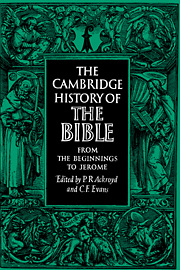Book contents
- Frontmatter
- I LANGUAGE AND SCRIPT
- II BOOKS IN THE ANCIENT WORLD
- III THE OLD TESTAMENT
- IV THE NEW TESTAMENT
- 9 THE NEW TESTAMENT IN THE MAKING
- 10 THE NEW TESTAMENT CANON
- 11 THE NEW TESTAMENT TEXT
- 12 THE INTERPRETATION OF THE OLD TESTAMENT IN THE NEW
- V THE BIBLE IN THE EARLY CHURCH
- Bibliography
- Abbreviations
- Notes on the Plates
- Indexes
- Plate Section">
- References
10 - THE NEW TESTAMENT CANON
from IV - THE NEW TESTAMENT
Published online by Cambridge University Press: 28 March 2008
- Frontmatter
- I LANGUAGE AND SCRIPT
- II BOOKS IN THE ANCIENT WORLD
- III THE OLD TESTAMENT
- IV THE NEW TESTAMENT
- 9 THE NEW TESTAMENT IN THE MAKING
- 10 THE NEW TESTAMENT CANON
- 11 THE NEW TESTAMENT TEXT
- 12 THE INTERPRETATION OF THE OLD TESTAMENT IN THE NEW
- V THE BIBLE IN THE EARLY CHURCH
- Bibliography
- Abbreviations
- Notes on the Plates
- Indexes
- Plate Section">
- References
Summary
The Canon of the New Testament was the result of a long and gradual process in the course of which the books regarded as authoritative, inspired, and apostolic were selected out of a much larger body of literature. Such a process of selection necessarily involved both selectors and grounds on which the selection would be made. As far as we know, the early selectors were anonymous. We may suppose that they were leaders in the Christian churches, but we do not know their names or the dates at which selections were made. Only in the late second century does it become clear that such leaders as Irenaeus of Lyons and Serapion of Antioch are consciously discussing questions of canon, and when they do so they are relying primarily on older Church traditions. This is not to say that such individuals lacked influence upon the process of selection; it is to say that their influence was exerted in favour of prior views and contemporary consensus. When we speak of selection it is clear that the process involves comparison between one book and another or among collections of books. The fact that the gnostic ‘library’ at Nag Hammadi includes books which may not have been gnostic in origin probably means that non-gnostic books were interpreted in gnostic ways by those who collected them. Similarly, the early Christian canonical collection implies that those who assembled or accepted it understood all the books as conveying essentially the same message.
Keywords
- Type
- Chapter
- Information
- The Cambridge History of the Bible , pp. 284 - 308Publisher: Cambridge University PressPrint publication year: 1970
References
- 4
- Cited by

